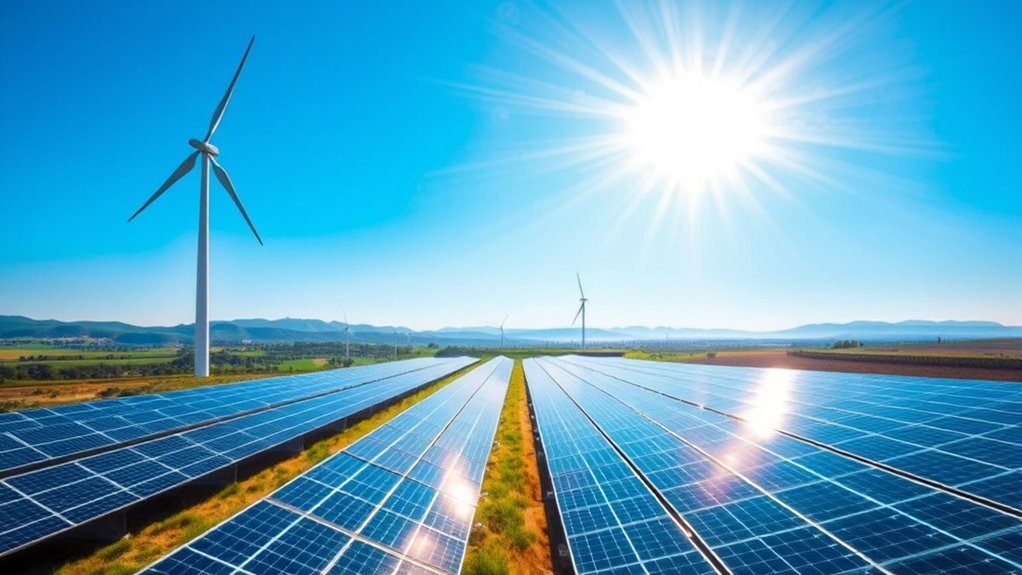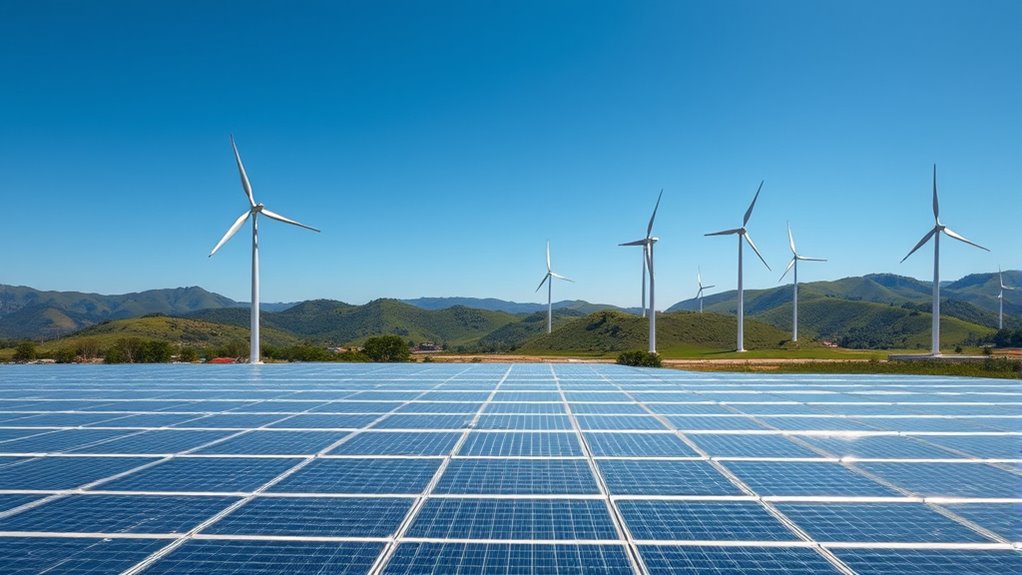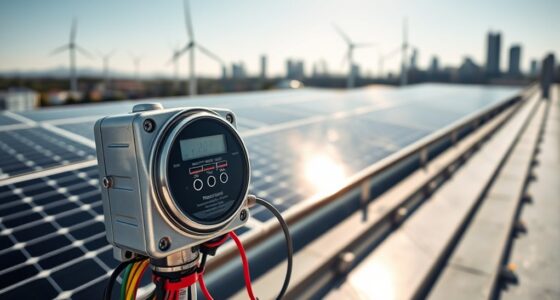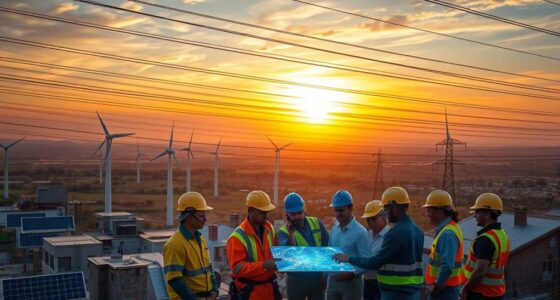Falling costs of solar, wind, and storage tech make renewable energy more affordable and accessible. When prices drop, investments surge as projects become financially viable in more regions. Advanced storage solutions stabilize supply and handle intermittency, boosting reliability. Supportive policies and incentives further reduce risks and attract funding. As these factors come together, renewables are booming around the world. To understand the full picture and what’s driving this shift, keep exploring the key details behind this growth.
Key Takeaways
- Decreasing costs of renewable technologies make projects more financially viable and attractive to investors worldwide.
- Advanced storage solutions improve grid stability, enabling higher renewable integration and reducing intermittency concerns.
- Policy incentives like tax credits and subsidies lower investment risks and accelerate renewable energy deployment.
- Technological innovations in storage and generation enhance efficiency and extend the economic feasibility of renewables.
- The combined effect of cost reductions, storage improvements, and supportive policies drives the rapid growth of renewable investments.

As renewable energy technologies become more affordable, investments in clean power sources are skyrocketing worldwide. This surge is driven by the declining costs of solar panels, wind turbines, and other renewable systems, making them more accessible and economically attractive. You’re likely aware that one of the main hurdles in expanding renewables has been how to manage their intermittent nature. That’s where storage solutions come into play. Advanced batteries and other energy storage technologies enable you to store excess power generated during peak times, then release it when demand is high or sunlight and wind are scarce. This not only stabilizes the grid but also maximizes the value of renewable assets, making investments more reliable and profitable.
Moreover, recent improvements in storage solutions have considerably reduced costs, further boosting the appeal of renewables. You can now deploy large-scale battery systems that are more efficient and affordable than ever before, allowing you to store energy for longer periods without prohibitive expenses. These innovations help smooth out supply fluctuations, meaning you can rely more on renewable sources and less on fossil fuels. As a result, projects become financially viable in regions previously considered unsuitable for renewables due to variability issues. Storage solutions are becoming integral to renewable infrastructure, transforming how you plan and operate clean energy systems. Additionally, energy storage advancements continue to evolve rapidly, further enhancing your ability to harness renewable energy efficiently.
Policy incentives also play a crucial role in this renewable boom. Governments worldwide recognize the importance of shifting to cleaner energy and are implementing policies that make investing in renewables more attractive. Tax credits, grants, and subsidies lower your upfront costs, reducing financial risks and encouraging more developers and individuals to participate. Feed-in tariffs and renewable portfolio standards create market stability, ensuring you can sell excess power at favorable rates. These incentives are designed to accelerate adoption, helping you see quicker returns on investment and making renewable projects more appealing across diverse sectors.
Together, falling costs of renewable technologies, innovative storage solutions, and robust policy incentives create a perfect environment for growth. If you’re considering investing in renewables, these factors greatly reduce barriers and improve profitability. They also guarantee that clean energy can become a reliable and dominant part of your energy mix, contributing to a more sustainable future. As these trends continue, the financial and environmental benefits of renewables will become even more compelling, making it easier for you to support and benefit from the global transition to sustainable power sources.
Frequently Asked Questions
How Do Renewable Energy Subsidies Impact Global Markets?
You might wonder how renewable energy subsidies influence global markets. Subsidy policies can reduce market volatility by providing financial support, making renewables more attractive to investors. This boosts demand and accelerates growth. However, inconsistent policies across countries can create uncertainty, affecting investment stability. Overall, subsidies play a vital role in shaping market dynamics, encouraging renewable adoption, and fostering a more balanced and sustainable global energy economy.
What Technological Innovations Are Driving Renewable Efficiency?
You see that technological innovations boost renewable efficiency by improving solar panels and wind turbines. Advanced materials like perovskite in solar cells increase energy absorption, while bifacial panels capture sunlight from both sides. For wind turbines, taller towers and larger blades harness more wind power. These innovations make renewables more effective, helping you generate more clean energy and reduce reliance on fossil fuels.
How Do Renewables Compare to Fossil Fuels in Energy Storage?
Imagine energy storage as a mighty vault, holding power for when the sun isn’t shining or wind isn’t blowing. Renewables excel here with higher energy density and scalable storage solutions, like giant batteries and pumped hydro. Fossil fuels, in contrast, offer limited scalability and lower energy density, making them less adaptable for modern needs. You find renewables more flexible, ready to grow with your energy demands, unlike the static fossil options.
What Are the Geopolitical Implications of Renewable Energy Investments?
You should consider how renewable energy investments reshape geopolitics by promoting energy sovereignty, reducing dependence on fossil fuel-rich nations. As you invest in renewables, you shift alliances, fostering new geopolitical relationships based on technology and resource-sharing rather than traditional oil and gas dominance. This shift could lead to more balanced global power dynamics, encouraging cooperation and stability, but it also risks disrupting existing alliances and creating new geopolitical tensions.
How Do Renewable Energy Projects Influence Local Communities Economically?
Renewable energy projects boost local communities by creating community benefits like improved infrastructure and cleaner environments. You see more local employment opportunities as these projects need workers for construction, maintenance, and operation. This not only injects money into the local economy but also fosters community pride. Overall, renewables empower communities economically, making them more resilient and attractive for future investments.
Conclusion
As you see, renewables are like a rising tide, lifting the future of energy with falling costs and soaring investments. With each new project, you’re witnessing a shift that’s as unstoppable as a wildfire spreading across the plains. Embracing these changes means you’re part of a movement that’s transforming our world—bright, sustainable, and full of promise. So, get ready to ride this wave, because renewables are here to stay, shining a light on a greener tomorrow.









